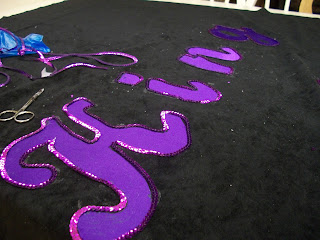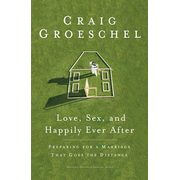 |
| The End Result is 4x7' and suits this big wall |
We are a church with a "traditional" style without being asleep. Our sanctuary was built in 1960 and is stately but needs some color. Banners from the bookstore or church supply run from $150-250 or more. We need some splash for a lot less cash. We have a long term plan to make 12 banners over time. The set will eventually contain three pairs of the large ones in liturgical colors and six smaller ones on the side walls. We are starting with the names of Christ. This first one is the test case and came out very well. The rest will assembled by families or Sunday School Classes receiving them in Kit Form. This helps the whole of the church "own" them while keeping them of good quality and unified in theme.
 Our secretary laid it out the design very quickly with a laser level with the fabric pinned to the office wall. She is amazing but it can be easily done on the floor with the yard stick and tape measure. The visual center needs to be a little higher than the actual middle of the fabric. Allow 2 extra inches at the top for the casing to hold the curtain rod and about 4 inches at the bottom for the "point".
Our secretary laid it out the design very quickly with a laser level with the fabric pinned to the office wall. She is amazing but it can be easily done on the floor with the yard stick and tape measure. The visual center needs to be a little higher than the actual middle of the fabric. Allow 2 extra inches at the top for the casing to hold the curtain rod and about 4 inches at the bottom for the "point".  The shapes were cut out of paper from the computer then traces onto the fabric that had "Wonder Under" ironed onto it. The shapes were cut out and then ironed onto the fabric.
The shapes were cut out of paper from the computer then traces onto the fabric that had "Wonder Under" ironed onto it. The shapes were cut out and then ironed onto the fabric.  The stones and trims were added with Aleene's "Super Fabric" glue. It strings a bit and you have to work fairly quickly but is very strong. The confirmation kids put the stones where they wanted them and I glued them on in about 15 minutes.
The stones and trims were added with Aleene's "Super Fabric" glue. It strings a bit and you have to work fairly quickly but is very strong. The confirmation kids put the stones where they wanted them and I glued them on in about 15 minutes. 
The shapes and letters were trimmed in strung sequins. I used a walmart bag to keep the glue strings off of the fabric.

This was hard for a novice guy-crafter at first. Without the trim the edges were ragged.
My first thought was to use shirt paint but the sequins added a cleaner line.
 I used cheap vinyl gloves to keep the glue off of my hands and found another benefit. The sequins did not stick to the gloves and could be pushed down into the glue.
I used cheap vinyl gloves to keep the glue off of my hands and found another benefit. The sequins did not stick to the gloves and could be pushed down into the glue. 
The fine point of the container caused problems with stringing but gave good control. By squeezing the sides of the tube you can pull the glue back into the tube and save some of the mess.

The letters took the longest to trim out. They were cut out of "wonder-undered" fabric after being traces off of computer prints. The sequins popped them out and made them sharp when seen at a distance.
A "casing" or pocket was made by turning over 2 inches of the fabric and gluing it at the top with a small bead of the glue. A cheap telescoping curtain rod slid into it the pocket. The rod was glued in the middle with the Aleene's glue to keep it from sliding and cording was tied to either end
The materials: 2 yards Fabric, assortment of assorted acrylic gems, Aleene's Super Fabric glue, 5 yards of strung sequins, 1 telescoping curtain rod, 1 yard 1" fringe, and 2 yards of wonder under iron on material, The project cost was around $40 and took 2-3 hours of time in three sittings.
Tools: plastic bag to shield the glue, small scissors, tape measure, yardstick, vinyl gloves (cheap cleaning ones),
What I learned:

- Start with a good and simple design. Detail is lost from a distance. Keep it simple and use few words. Lighter weight and colored fabrics showed stains from the glue! Don't get excited though. They don't show from a distance.
- Have a "Big Picture" plan with a theme and some boundaries. Yet...let the detail oriented people work up the details. Let the crafters and quilters get on board creatively. Use this as a way to forge a relationship between the congregation and worship.
- The ratio of 1/2 as wide as it is long is good. look at your space. The bigger the space the bigger the banner. The letters need to be bigger than you think-fill up the fabric with big letters and few words.
- Get a seamstress to lay it out. My secretary got the project started correctly and this is how we got such a good result. .
- The fabric needs some body or it won't hang straight. This is "sueded" polyester. It was on sale, looks great and forgave the glue smears. It should last a long time too. A quick brush with the lint roller and it looks super.
- This is not a big group project. I started this out as a confirmation class project but ended up finishing my self. One or two people that get along can do it quickly. I glued on all of the sequins in an hour while I watched Leno.
- You won't lose your "guy card" doing this. Anyone, though a novice and non-sewer, can achieve great results but I counted on others to pick out the colors. Lots of people brought pictures and ideas.
- The fringe on the bottom not only added some flash but helped to hold the shape of the bottom. The only thing I would change would be to add some flat gold trim to the sides.
- Don't Forget-this is a prayer and not merely an arts and crafts project. Teach with it, worship with it and expect Christ to use our efforts to make disciples.
 |
| This one looks good now. More Banners will be added over time |











.JPG)
.JPG)
.JPG)


